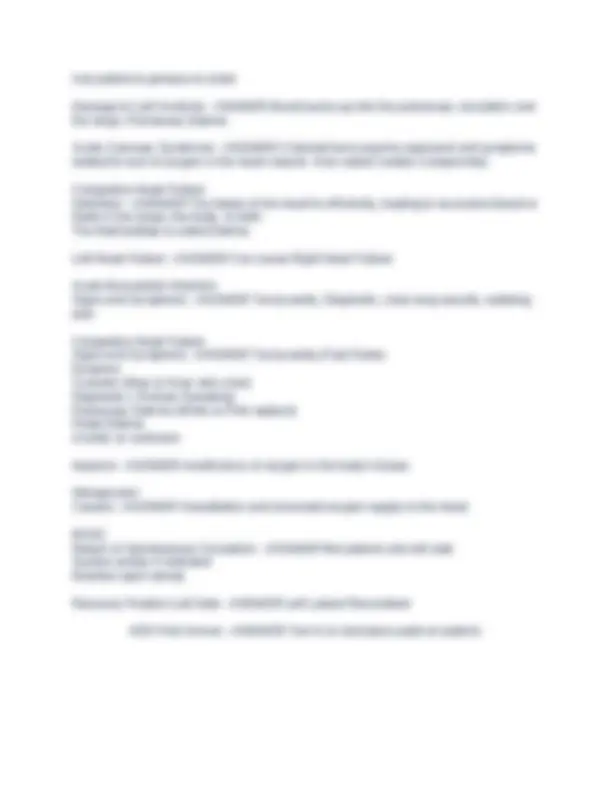



Study with the several resources on Docsity

Earn points by helping other students or get them with a premium plan


Prepare for your exams
Study with the several resources on Docsity

Earn points to download
Earn points by helping other students or get them with a premium plan
Community
Ask the community for help and clear up your study doubts
Discover the best universities in your country according to Docsity users
Free resources
Download our free guides on studying techniques, anxiety management strategies, and thesis advice from Docsity tutors
Cardiac Arrest Treatment - ANSWER Rapid CPR and early application of an AED. Maintain open airway, apply high concentration of oxygen, non rebreather mask.
Typology: Exams
1 / 3

This page cannot be seen from the preview
Don't miss anything!


Cardiac Arrest Treatment - ANSWER Rapid CPR and early application of an AED. Maintain open airway, apply high concentration of oxygen, non rebreather mask. Dyspnea - ANSWER Shortness of breath, labored or difficulty breathing. AED Indications - ANSWER Pulseless Not Breathing Unresponsive AED Use - ANSWER AED says "analyzing" do not touch patient. Chest Pain - ANSWER Administer Oxygen AED Shockable Rhythms - ANSWER V-Tach V-Fib Acute Myocardial Infarction - ANSWER Often called a Heart Attack. The condition in which a portion of the myocardium dies as a result of oxygen starvation. Best known heart problem symptom - ANSWER Chest Pain AED Single Shock - ANSWER After a single shock from an AED, and patient regains pulse, place patient in recovery position. Coronary Arteries - ANSWER Blood vessels that supply the myocardium Congestive Heart Failure - ANSWER Congestive Heart Failure is often a complication with a heart attack. Cardiogenic Shock - ANSWER Shock or lack of perfusion brought on by inadequate pumping action of the heart. Often the result of a heart attack or congestive heart failure. Angina Pectoris - ANSWER Pain in the chest. In this condition coronary artery disease has narrowed the arteries that supply the heart. Occurring when blood supply to the heart is reduced and a portion of the heart muscle is not recieving enough oxygen.
Coronary Artery Disease - ANSWER Conditions that narrow or block the arteries of the heart. Coronary artery disease is often the result of buildup of fatty deposits on the inner walls of the arteries. Right Sided Heart Failure - ANSWER Pedal Edema Identify Stroke - ANSWER Cincinnati Prehospital Stroke Scale Facial Droop Arm Drift Slurred Speech Altered Mental Status Hypoperfusion - ANSWER Also known as shock. Inability of the body to adequately circulate blood to the body's cells to supply them with oxygen. Nitroglycerin - ANSWER Taken by patient's who have chest pain of cardiac origin. Dilates the blood vessels Left Ventricle - ANSWER Pumps oxygenated blood to the body. Coronary Artery Diseases - ANSWER Angina Pectoris Acute Myocardial Infarction Congestive Heart Failure Left Sided Heart Failure - ANSWER Pulmonary Edema Anatomy of the Heart - ANSWER Right Atrium to Right Ventricle Left Atrium to Left Ventricle Artery - ANSWER Carries blood away from the heart Viens - ANSWER Carry blood to the heart Cardiac Medications - ANSWER Nitroglycerin Aspirin Cardiac Dysrrhythmia - ANSWER Irregular heartbeat. Improper beating of the heart, too fast or too slow Storke Assessment - ANSWER Facial Assessment